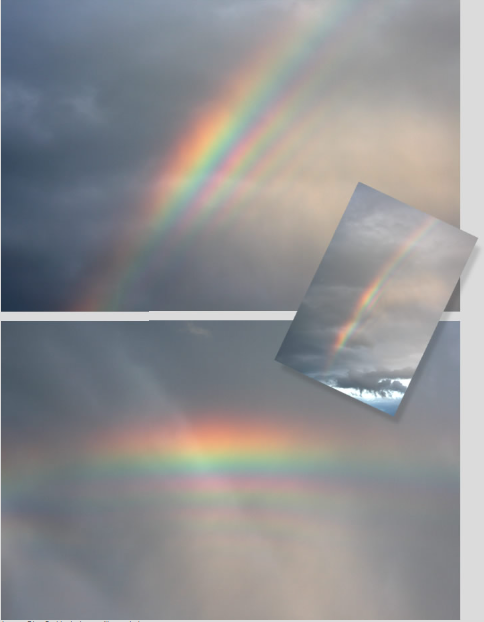Multiple Supernumerary Bows
Multiple Supernumerary Bows: A Rare and Intriguing Atmospheric Phenomenon
Have you ever witnessed a rainbow that seemed to defy the norms of nature? While rainbows are a relatively common sight, there are occasions when they exhibit extraordinary features. One such phenomenon is the occurrence of multiple supernumerary bows, which are characterized by additional fringes of color inside the primary bow. These captivating optical displays arise from the interference of light waves passing through raindrops of specific sizes. In this article, we will delve into the fascinating world of multiple supernumerary bows and explore their rare sightings and underlying causes.
Supernumeraries are not always visible, and when they do appear, only one or two fringes are typically observed. However, in exceptional cases like the one witnessed by Ian Goddard in Ashill, Somerset, UK on August 7th, 2007, multiple supernumerary bows can manifest. This unique sighting revealed at least four fringes in two distinct fans, with their spacing increasing as they reached higher altitudes in the sky.
The spacing between the fringes within a supernumerary bow is directly influenced by the size of the raindrops. As the drop size decreases, the fringe spacing increases. In the case of the rare sighting in Ashill, it is likely that two localized rain showers occurred, each with raindrops of varying sizes at different altitudes. This change in drop size with altitude resulted in the creation of multiple supernumerary bows with increasing fringe spacing.
Ordinarily, rain showers consist of a distribution of raindrop sizes, leading to overlapping spacings between supernumerary bows and blurring out all but the first one or two fringes. However, in the extraordinary sighting in Ashill, the drops at a particular height must have exhibited an exceptionally similar size, allowing four fringes to survive and be visible to the observer. Such precise conditions are quite rare and add to the wonder of witnessing multiple supernumerary bows.
Interestingly, a similar display of multiple supernumerary bows was observed in Statesville, North Carolina. This sighting further reinforces the uniqueness and rarity of this atmospheric phenomenon. While the precise mechanisms behind the formation of these bows are still being studied, their occurrence in different locations suggests that certain weather conditions may contribute to their manifestation.
In conclusion, multiple supernumerary bows are a captivating and rare spectacle in the realm of atmospheric optics. These additional fringes of color within the primary bow arise from the interference between light waves passing through raindrops of specific sizes. While supernumeraries are typically limited to one or two fringes, extraordinary circumstances can lead to the appearance of multiple fringes in distinct fans. The spacing between these fringes is influenced by the size of the raindrops, and localized rain showers with varying drop sizes at different altitudes can create the conditions necessary for the formation of multiple supernumerary bows. So, keep your eyes peeled during rain showers, as you might just be fortunate enough to witness this awe-inspiring optical phenomenon!

Ian Goddard saw this rarity at Ashill in Somerset, UK on 7th August 2007.
The rainbow orientation is as in the smaller tilted image.
Purple and green fringes inside the primary bow are supernumeraries. They are caused by interference between pairs of light waves passing through rather small raindrops.
Supernumeraries are not always visible and when they are, only one or two are usually seen. In this rare sighting there are at least four in two fans where their spacing increases with height in the sky.
The fringe spacing increases with decreasing drop size and it is likely that the fans were produced by two localised rain showers in which the drop size changed with altitude.
Rain showers usually have a distribution of drop sizes resulting in supernumerary bows with a range of spacings which overlap to blur out all but the first one or two fringes. Here the drops at a given height must have been extraordinarily similar in size to allow four fringes to survive.
A similar display was seen at Statesville, North Carolina.
Note: this article has been automatically converted from the old site and may not appear as intended. You can find the original article here.
Reference Atmospheric Optics
If you use any of the definitions, information, or data presented on Atmospheric Optics, please copy the link or reference below to properly credit us as the reference source. Thank you!
-
<a href="https://atoptics.co.uk/blog/multiple-supernumerary-bows/">Multiple Supernumerary Bows </a>
-
"Multiple Supernumerary Bows ". Atmospheric Optics. Accessed on April 20, 2024. https://atoptics.co.uk/blog/multiple-supernumerary-bows/.
-
"Multiple Supernumerary Bows ". Atmospheric Optics, https://atoptics.co.uk/blog/multiple-supernumerary-bows/. Accessed 20 April, 2024
-
Multiple Supernumerary Bows . Atmospheric Optics. Retrieved from https://atoptics.co.uk/blog/multiple-supernumerary-bows/.